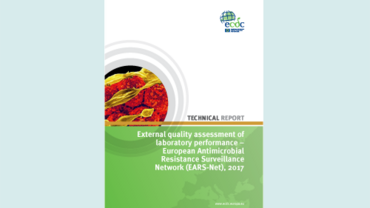Surveillance of antimicrobial resistance in Europe 2017
EARS-Net data for 2017 show that antimicrobial resistance remains a serious threat in Europe. For invasive bacterial infections, prompt treatment with effective antimicrobial agents is especially important and is one of the single most effective interventions to reduce the risk of fatal outcome. The high percentages of resistance to key antimicrobial groups reported from many countries are therefore of great concern and represent a serious threat to patient safety in Europe. Prudent antimicrobial use and comprehensive infection prevention and control strategies targeting all healthcare sectors are the cornerstones of effective interventions aiming to prevent selection and transmission of bacteria resistant to antimicrobial agents.
Executive Summary
The results presented in this report are based on antimicrobial resistance data from invasive isolates reported to the European Antimicrobial Resistance Surveillance Network (EARS-Net) by 30 European Union (EU) and European Economic Area (EEA) countries in 2018 (data referring to 2017), and on trend analyses of data reported by the participating countries for the period 2014 to 2017.
Despite the political prioritisation of antimicrobial resistance as a threat to public health and the availability of evidence-based guidance for antimicrobial stewardship and infection prevention and control, high levels of resistance remain in the EU/EEA for several bacterial species–antimicrobial group combinations. Intercountry variations also indicate that there is scope for significant reductions in antimicrobial resistance in many countries through strengthening of current best practice.
The antimicrobial resistance situation in Europe displays wide variations depending on the bacterial species, antimicrobial group and geographical region. For several bacterial species–antimicrobial group combinations, a north-to-south and west-to-east gradient is evident. In general, lower resistance percentages were reported by countries in the north while higher percentages were reported in the south and east of Europe.
For Escherichia coli and Klebsiella pneumoniae, combined resistance to several antimicrobial groups was frequent, and extended-spectrum beta-lactamase (ESBL) production was common. Resistance percentages were generally higher in K. pneumoniae than in E. coli. For E. coli, there was a small but significant increase in the trend of the EU/EEA population-weighted mean percentage for third-generation cephalosporin resistance from 14.2% in 2014 to 14.9% in 2017, a trend that remained significant when only laboratories reporting consistently during all four years were included. By contrast, no significant trends were noted for the K. pneumoniae EU/ EEA population-weighted mean resistance percentages when restricting analyses to the laboratories that consistently reported data during the four-year period.
While carbapenem resistance remained rare in E. coli, several countries reported carbapenem resistance percentages above 10% for K. pneumoniae. Carbapenem resistance was also common in Pseudomonas aeruginosa and Acinetobacter species, and at higher percentages compared with K. pneumoniae. For all four gram-negative bacteria, the countries reporting the highest carbapenem resistance percentages were also among the countries reporting the highest resistance percentages for other antimicrobial groups.
For Streptococcus pneumoniae, the resistance situation appeared stable between 2014 and 2017, but with large inter-country variations. Macrolide non-susceptibility was, for most countries, more frequent than penicillin non-susceptibility.
For Staphylococcus aureus, the decline in the percentage of meticillin-resistant, i.e. MRSA, isolates reported in previous years continued in 2017. The EU/EEA population-weighted mean MRSA percentage decreased significantly from 19.6% in 2014 to 16.9% in 2017, with similar decreasing trends reported from more than one fourth of the countries. Nevertheless, MRSA remains an important pathogen in the EU/EEA, as the levels of MRSA were still high in several countries, and combined resistance to other antimicrobial groups was common.
Among enterococci, the increasing trend of Enterococcus faecium resistant to vancomycin is a cause of concern. The EU/EEA population-weighted mean percentage increased significantly from 10.4% in 2014 to 14.9% in 2017, and corresponding increasing trends were noted in around one third of the countries.
Download

The latest country-specific data can be retrieved from the ECDC Surveillance Atlas of Infectious Diseases







